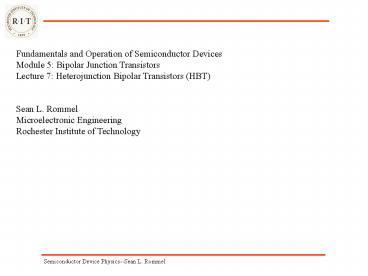Module 5 Lecture SiGe Heterojunction Bipolar Transistors PowerPoint PPT Presentation
1 / 20
Title: Module 5 Lecture SiGe Heterojunction Bipolar Transistors
1
Fundamentals and Operation of Semiconductor
Devices Module 5 Bipolar Junction
Transistors Lecture 7 Heterojunction Bipolar
Transistors (HBT) Sean L. Rommel
Microelectronic Engineering Rochester Institute
of Technology
2
Bipolar Junction Transistors HBT
III. Field in the Base
B. Compositionally Graded Base Region
- Grading the composition may also create a drift
field in the base region.
- One semiconductor will be used for the emitter
(Si), and a second will be used for the base
(SiGe)
Before proceeding further, let us develop some
theory regarding the formation of heterojunctions.
3
Bipolar Junction Transistors HBT
Aside Heterojunctions
Definition of Heterojunction
A crystalline structure comprised of two
dissimilar materials
Each material will have different properties
1.) Lattice Constant
2.) Bandgap
3.) Mobility
4
Bipolar Junction Transistors HBT
Aside Heterojunctions
Definition of Heterojunction
Depending on the strain resulting from the
difference between lattice constants, the
material may be classified as
1.) Lattice Matched
Perfect Crystal, not under strain. May be
infinitely thick.
Lattice mismatched crystal grown past a
critical thickness Stress relieved via misfit
dislocations.
2.) Relaxed
3.) Pseudomorphic
Lattice mismatched crystal, under strain but
below the critical thickness.
5
Bipolar Junction Transistors HBT
Lattice Matched
ahostaepitaxy
Epitaxial layer
Host Crystal
Little or no strain!
6
Bipolar Junction Transistors HBT
Biaxial Compressive Strain
ahostltaepitaxy
Epitaxial layer
Strain Field
Host Crystal
7
Bipolar Junction Transistors HBT
Biaxial Tensile Strain
ahostgtaepitaxy
Epitaxial layer
Strain Field
Host Crystal
8
Bipolar Junction Transistors HBT
Pseudomorphic
Relaxed
tltcritical thickness
tgtcritical thickness
9
Bipolar Junction Transistors HBT
We would like for our BJTs to be pseudomorphic.
10
Bipolar Junction Transistors HBT
When we create a compound semiconductor, the
material retains properties of each constituent
element
Si
Ge
Lattice Constant
Bandgap
Dielectric Constant
Growing Si1-xGex on Si results in compressive
strain!
11
Bipolar Junction Transistors HBT
What happens if we put the narrow gap material
(SiGe) in the base?
What happens if we grade the Ge composition such
that it is highest at the B-C junction?
x
12
Bipolar Junction Transistors HBT
- The collector current is strongly affected by
the addition of Ge!
- Because the intrinsic carrier concentration is
a function of position, we must have an electric
field in the base!
13
Bipolar Junction Transistors HBT
For a total bandgap narrowing of 100 meV,
- Base Electric Field 104 V/cm
Thus, the ratio of the Si to SiGe base transit
time is given by
Equation 67
14
Bipolar Junction Transistors HBT
The incorporation of SiGe in the base results in
a shorter transit time!
For DEg100 meV, the transit time for SiGe is 2.5
times faster!
15
Bipolar Junction Transistors HBT
What happens to the Early Voltage?
We recall that
Equation 68
Adding SiGe to the base results in
Equation 69
16
Bipolar Junction Transistors HBT
Therefore,
Equation 70
For DEg100 meV, VASiGe is 12 times larger than
VASi!
17
Bipolar Junction Transistors HBT
For boxlike doping profiles and low currents,
Equation 71
And,
Equation 72
18
Bipolar Junction Transistors HBT
Since the base current of a Si transistor is
virtually identical to a SiGe transistor,
Equation 73
SiGe greatly enhances the gain of a BJT!
For DEg100 meV, bSiGe is 4-6 times larger than
bSi!
19
Bipolar Junction Transistors HBT
The total performance enhancement may be seen via
the product of Early Voltage and Gain
Equation 74
For DEg100 meV, bSiGeVASiGe is 50 times larger
than bSiVASi!
20
Bipolar Junction Transistors HBT
Review Questions
1.) What is the difference between lattice
matched, pseudomorphic, and relaxed films?
2.) Is SiGe on Si compressive or tensile?
3.) How does SiGe in the base alter device
performance?

